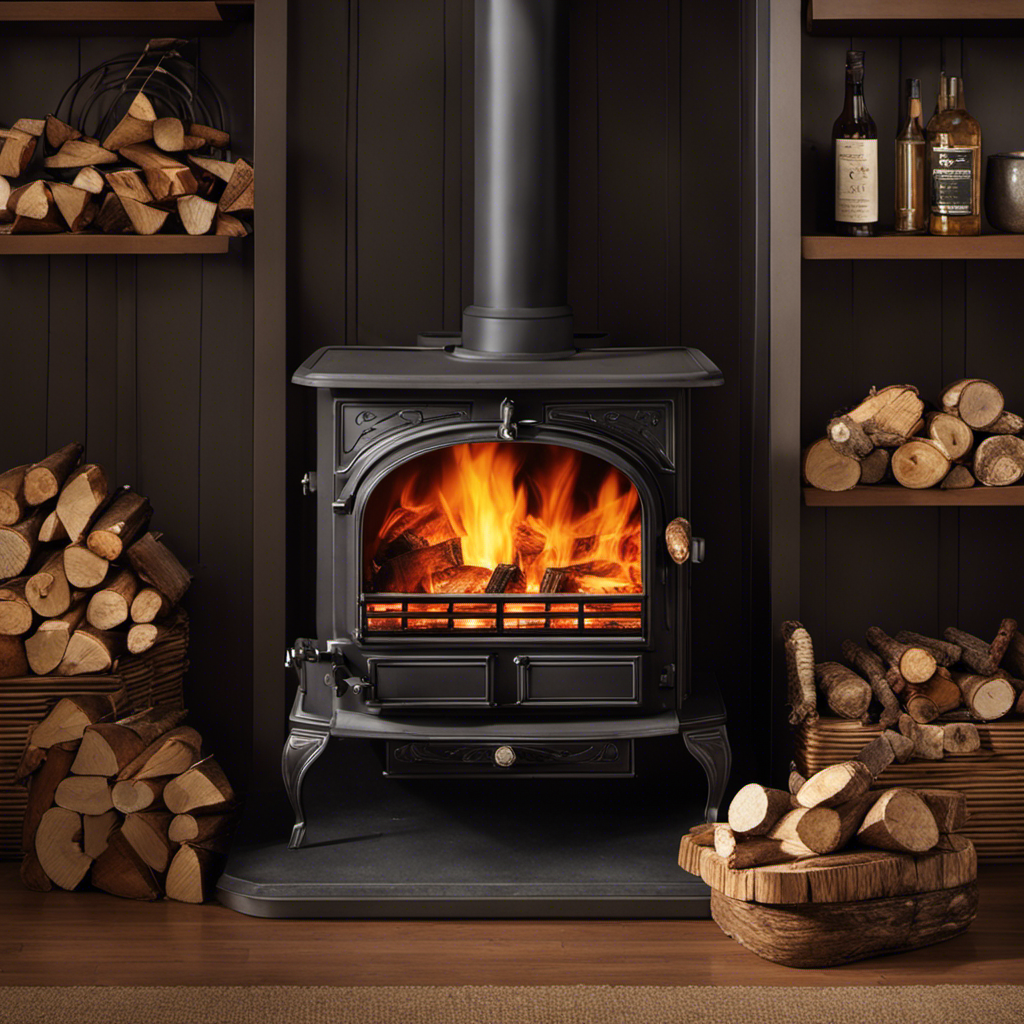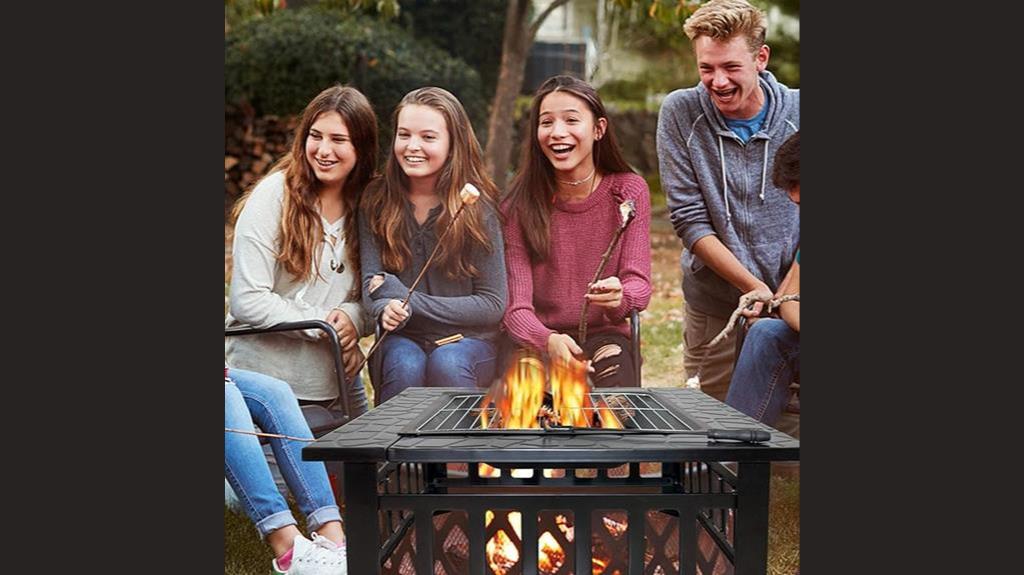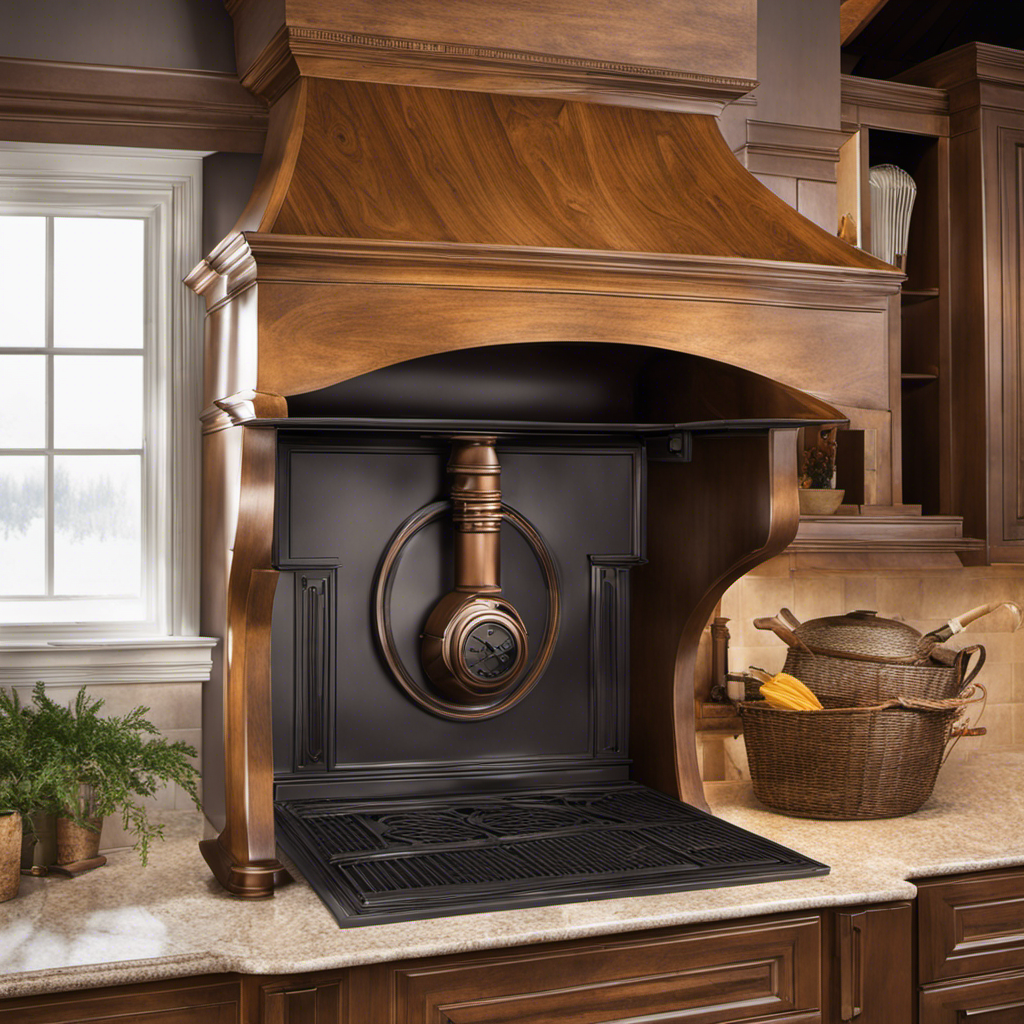Snuggled up next to the cozy fire, I feel a sense of comfort and peace enveloping me, creating a serene atmosphere. But what if there was a way to prolong the burn time of my wood stove, allowing me to savor these peaceful moments for even longer?
In this article, I will share with you simple yet effective techniques to achieve just that. From properly seasoned firewood to efficient airflow control, insulation, and regular maintenance, I will guide you step by step on how to maximize the burn time of your wood stove.
Let’s get started and make those fires last.
Key Takeaways
- Properly season firewood to reduce moisture content and improve combustion efficiency
- Use a damper to control airflow and optimize wood stove performance
- Improve insulation and heat retention with thermal barriers and draft stoppers
- Regularly maintain and clean the wood stove for optimal performance and reduced fire hazards
Properly Seasoned Firewood
I always make sure to use properly seasoned firewood for my wood stove. The moisture content of firewood plays a crucial role in its performance and efficiency. When wood is freshly cut, it contains a high moisture content, typically around 50%. This moisture needs to be reduced to around 20% for optimal burning.
The drying process involves storing the wood in a well-ventilated area, allowing air circulation to facilitate the evaporation of moisture. It usually takes about 6-12 months for the firewood to properly dry. Using wood with a high moisture content can lead to inefficient combustion, increased smoke production, and the formation of creosote in the chimney.
Now that we understand the importance of properly seasoned firewood, let’s move on to the next topic: efficient airflow control.
Efficient Airflow Control
Using a damper to regulate the amount of air entering the wood stove is a key technique for achieving efficient airflow control. Properly controlling the air intake can help you maximize the burn time of your wood stove and ensure optimal heat output.
Here are three important factors to consider when it comes to damper control:
-
Opening the damper fully allows for maximum air intake, resulting in a hotter and more intense fire. This is ideal for quickly heating up a room or when you need a high heat output.
-
Closing the damper partially restricts the air intake, slowing down the combustion process. This is useful for maintaining a steady and longer burn, especially during the night or when you want to conserve fuel.
-
Adjusting the damper based on the wood’s moisture content is crucial. Wet wood requires more air to burn efficiently, so you may need to open the damper wider. Dry wood, on the other hand, needs less air, so you can close the damper slightly to control the burn rate.
Mastering damper control allows you to optimize the performance of your wood stove, ensuring efficient burning and longer burn times.
Insulation and Heat Retention
One important factor in maximizing heat retention is ensuring that the wood stove has adequate insulation. Thermal barriers and draft stoppers play a crucial role in preventing heat loss and keeping the fire burning longer.
Thermal barriers are materials that are placed around the wood stove to reflect heat back into the room. This can be achieved by using materials like fireproof bricks or ceramic tiles.
Draft stoppers, on the other hand, are devices that help seal any gaps or cracks in the stove or chimney, preventing cold air from entering and warm air from escaping. These can be simple solutions like caulking or weatherstripping.
Regular Maintenance and Cleaning
To ensure optimal performance and prevent build-up, regular maintenance and cleaning of my wood stove is essential. Here are some cleaning techniques and a maintenance schedule that I follow to keep my wood stove in top shape:
-
Clean the firebox: I remove any ashes and debris from the firebox using a metal scoop and a fireplace brush. This helps maintain proper airflow and prevents blockages.
-
Check the chimney: I inspect the chimney for any creosote buildup or obstructions. If needed, I use a chimney brush to remove the creosote and ensure efficient ventilation.
-
Deep clean the stove: Once a year, I disassemble the stove and clean each part thoroughly. I use a mild detergent and warm water to clean the exterior and a wire brush to remove any rust or residue from the interior.
Regular maintenance and cleaning keep my wood stove running efficiently and reduce the risk of fire hazards.
Now, let’s move on to the next section about using stove accessories for a longer burn time.
Using Stove Accessories for Longer Burn Time
I always use a few stove accessories, like a heat-resistant fan and a stove thermometer, to ensure a longer burn time and maximize the efficiency of my wood stove. These accessories not only help me keep my home warm but also save me money on heating costs.
One of the accessories that I find particularly helpful is a heat-resistant fan. This fan helps to distribute the heat more evenly throughout the room, allowing me to enjoy the warmth in every corner.
Another important accessory is a stove thermometer. This helps me monitor the temperature inside the stove, ensuring that it’s operating at the optimal level.
Additionally, some wood stoves come with catalytic converters and heat-resistant glass doors. These features further increase the efficiency of the stove by trapping and recirculating heat, resulting in a longer burn time.
Overall, using stove accessories is a smart way to enhance the performance of your wood stove and maximize its burn time.
Frequently Asked Questions
How Do I Choose the Right Type of Wood for My Wood Stove?
Choosing the right type of wood for your wood stove can greatly affect its burn time and efficiency. Hardwoods like oak, maple, and birch burn slower, while seasoned, smaller pieces with around 20% moisture content provide optimal burn time and heat output. Proper storage is also important.
Can I Use Softwood Instead of Hardwood for Longer Burn Time?
Using softwood instead of hardwood can result in a longer burn time for your wood stove. Softwood burns faster but produces more heat. It’s a great option if you want a longer-lasting fire.
Is It Necessary to Have a Chimney Cap for My Wood Stove?
Using a chimney cap for a wood stove has several benefits, such as preventing downdrafts and keeping out animals and debris. To install one properly, ensure it fits securely and is made of durable materials.
How Often Should I Clean the Chimney to Maintain Efficient Airflow?
To maintain efficient airflow, it is important to clean the chimney regularly. Signs that indicate a chimney needs cleaning include decreased efficiency of the wood stove and the presence of smoke or odors inside the house.
What Are Some Common Stove Accessories That Can Help Extend the Burn Time?
To extend the burn time of a wood stove, I can use accessories like a stove fan or a heat-powered stove top fan. Properly stacking wood can also help maximize stove heat output.
Conclusion
In conclusion, by following these simple steps, you can maximize the burn time of your wood stove.
Ensuring your firewood is properly seasoned, controlling airflow efficiently, and maintaining insulation and heat retention will all contribute to a longer burn.
Regular maintenance and cleaning will also help optimize your stove’s performance.
Additionally, utilizing stove accessories can further extend burn time.
By implementing these strategies, you can enjoy a cozy and efficient wood stove experience for longer periods.











